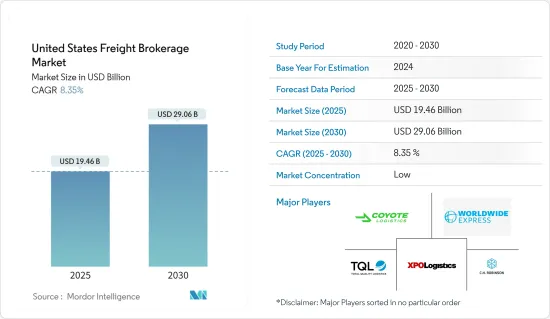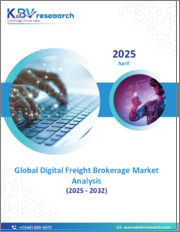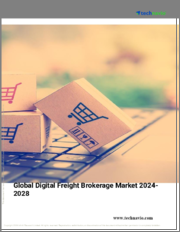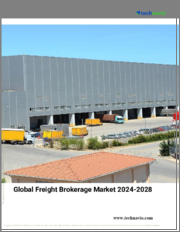
|
시장보고서
상품코드
1687895
미국의 화물 중개 시장 : 시장 점유율 분석, 산업 동향, 통계, 성장 예측(2025-2030년)United States Freight Brokerage - Market Share Analysis, Industry Trends & Statistics, Growth Forecasts (2025 - 2030) |
||||||
미국의 화물 중개 시장 규모는 2025년에 194억 6,000만 달러로 추정되고, 예측 기간인 2025-2030년 CAGR 8.35%로 성장할 전망이며, 2030년에는 290억 6,000만 달러에 달할 것으로 예측됩니다.

주요 하이라이트
- 산업 소식통의 정보에 의하면, 미국의 화물 중개 분야의 화물 시장 전체에 대한 침투도는 높아지고 있습니다. 미국 시장의 참가 기업이 처리하는 엔트리 수는 해마다 꾸준히 증가하고 있습니다. 미국, 멕시코 및 캐나다 협정(USMCA)에 의해 국경을 초월한 운송이 합리화되어 북미의 공급망에 통일성이 생길 것으로 기대되고 있습니다.
- 미국 시장에서는 트럭 운전자 부족이 계속되고 있어 운송업자에 크게 의존하는 중개와 같은 사업에는 악영향이 미치고 있습니다. 이 시나리오로 인해 화물 중개는 화주에게 더 높은 가격을 제시하지 않을 수 없게 되어 시장의 가격 상승과 경쟁으로 이어집니다.
- 미국의 LTL(less-than-truckload) 부문은 경쟁업체 간의 격렬한 적대관계에 직면하고 있습니다. LTL 화물 중개는 북미 LTL의 기술 혁신에 관여하여 다음 수익 개선을 추진하고 있습니다.
미국의 화물 중개 시장 동향
최근, 이 나라에서는 FTL 서비스가 기세를 늘리고 있습니다.
- 최근 미국에서는 내륙 화물 운송과 미국, 캐나다, 멕시코 간 국경을 넘은 무역 수요로 인해 풀 트럭 적재(FTL) 서비스가 크게 성장하고 있습니다. 풀 트럭 적재 화물 중개는 아직 성장 단계에 있어, 신규 화주에게 있어서 국내 시장에 참가하는 큰 매력이 되고 있습니다. 그러나 실적이 있는 화주는 국제 화물 운송 산업에서 주도적인 지위를 얻기 위해 중개 회사나 운송 회사와의 장기 계약을 요구하고 있습니다.
- FTL 중개사는 화주를 위해 운송 서비스를 홍보하고 운송 회사의 출하를 모니터링합니다. 많은 화물 중개 회사는 디지털 시장을 강화해, 자동 가격 설정, 애플리케이션 프로그래밍 인터페이스(API) 접속, 데이터 사이언스, 사내용 기술 등의 기술을 도입하고 있습니다. 미국 트럭 적재 화물 중개 시장의 주요 기업으로는 C.H. Robinson, XPO Logistics, Total Quality Logistics, Echo Global Logistics, Coyote Logistics 등이 있습니다.
- 2023년 1월, Schneider National Inc는 샌디에고의 자율주행 기술 회사인 TuSimple에 투자한다고 발표했습니다. 이 회사의 고객으로는 UPS, 미국우정공사, 맥클레인사 등이 있습니다. 이 회사는 또한 엔비디아(Nvidia)나 아마존(Amazon) 등의 하이테크 대기업과도 제휴하고 있습니다. 2022년 11월 구글과 JB Hunt는 JB 헌트의 디지털 전환을 가속화하고 공급망 플랫폼 기술로 협업하기 위한 다년간의 전략적 제휴를 발표했습니다. 구글 클라우드를 활용함으로써 JBHunt는 배송과 이용 가능한 용량을 디지털로 연결하는 JBHunt 360° 플랫폼을 확대할 전망입니다. 구글의 데이터 클라우드를 활용함으로써 JB헌트360은 인공지능과 기계학습 도구를 사용하여 결과를 예측하고 사용자에게 힘을 실어주며 정보에 입각한 의사결정을 할 수 있습니다.
제조업 및 자동차 산업이 향후 시장을 견인
- 활황을 보이는 미국의 자동차 산업에서는 항구에서 항구로의 운송, 저스트 인 타임(JIT) 배송, 저스트 인 시퀀싱(JIS) 배송 등 최대한의 가용성과 신뢰성을 갖춘 자동차 물류 솔루션이 요구되고 있습니다. 이 시장의 성장은 주로 신흥국의 자동차 생산 증가와 각국 정부가 자동차 산업에 부과하는 엄격한 규제 기준과 같은 요인에 의해 초래됩니다. 예를 들어 2023년 미국 자동차 산업은 견조한 판매를 기록했으며 약 312만 대의 자동차가 판매되었습니다. 게다가 미국 시장에서 자동차와 소형 트럭의 총 판매량은 1,550만 대에 달했습니다.
- 전기자동차의 채용 확대, 제품의 품질과 안전성에 대한 소비자 의식 고조, 자동차 산업에서 커넥티드 디바이스의 채용 증가에 수반하는 기술적 진보의 섭취는 시장 진출 기업에 성장 기회를 제공합니다. NAFTA의 자동차 제품 원산지 규칙은 관세 변경만 또는 관세 변경과 지역적인 함유 가치 요건을 기반으로 합니다. 동 협정은, 이러한 제품의 지역적 부가가치 함유율을 정미 코스트법으로 계산하는 것을 의무화하고 있습니다.
- 협정 발효 시, 자동차, 경차, 엔진, 트랜스미션의 지역별 분석 요건은 순원가 방식으로 50%입니다. 2022년, 정리해고의 증가로 미국의 공장 활동은 1년 반 이상 만의 저성장이 되어, 제조업체 각사는 중국의 제로 트렐런스 시책에 의한 여름철의 공급을 염려했습니다.
- 미국 제조업의 쇠퇴는 격차를 확대하고, 이 나라의 국제경쟁을 저하시키고 있습니다. 제조업이 활성화되면 150만 명의 고임금 일자리가 경제에 더해지고 소외된 지역 사회가 활성화될 수 있습니다. 혁신과 디지털화의 결과, 제조업은 르네상스를 경험할 가능성이 있습니다. 오랜 세월에 걸쳐 업종과 지역에 따라 성장의 편차가 있었기 때문에 번영하는 산업도 있었고 침체된 산업도 있었습니다.
미국의 화물 중개 산업의 세분화
미국의 화물 중개 시장은 중간 정도로 부문화되어 있어 지역의 대기업, 세계 기업, 현지 중소기업이 존재하고, 시장에 진입하고 있는 기업은 소수입니다. C.H. Robinson이 산업을 지배하고 XPO Logistics와 Hub Group/Mode Transportation이 그 뒤를 잇습니다. 화물 중개 시장은 톱 헤비로 상위 8-10개사가 총 수입의 3분의 1 이상을 차지하고 있습니다.
기술 통합에 관해서는 Convoy, Uber Freight, uShip과 같은 신규 진출 기업이 운임 투명성, 온라인 적하 보드, 모바일 앱으로 운임 예약 시장을 제공함으로써 큰 시장 점유율을 획득할 전망입니다. Trucking-as-a-Service(TaaS)는 기술 개발과 디지털 화물 운송의 수요에 의해 국내에서 크게 성장할 것으로 예상됩니다.
기타 혜택
- 엑셀 형식 시장 예측(ME) 시트
- 3개월간의 애널리스트 서포트
목차
제1장 서론
- 조사의 성과
- 조사의 전제
- 조사 범위
제2장 조사 방법
- 분석 방법
- 조사 단계
제3장 주요 요약
제4장 시장 개요
- 현재의 시장 시나리오
- 시장 역학
- 성장 촉진요인
- 전국적인 건설 러쉬
- 국내에서의 화물 중개 증가
- 성장 억제요인
- 화물의 경로 변경 및 기타 요인
- 전국적인 화물 수입 감소
- 기회
- 석유 및 가스 산업에서 수요 증가
- 화물 중개 시스템 및 물류의 기술적 진보
- 성장 촉진요인
- 산업의 매력-Porter's Five Forces 분석
- 공급기업의 협상력
- 구매자 및 소비자의 협상력
- 신규 참가업체의 위협
- 대체품의 위협
- 경쟁 기업간 경쟁 관계
- 산업 밸류체인 분석
- 미국 물류산업(개요, 동향, 연구개발, 주요 통계 등)
- 주요 정부 규제와 대처
- 운임에 대한 통찰
- 기술 스냅샷(디지털 화물 중개, IoT 등)
- 미국 통관 부문에 관한 정성적 및 정량적 인사이트
- COVID-19가 시장에 미치는 영향
제5장 시장 세분화
- 서비스별
- LTL
- FTL
- 기타
- 최종 사용자별
- 제조 및 자동차
- 석유 및 가스, 광업, 채석업
- 농업, 어업, 임업
- 건설업
- 유통업(도매업, 소매업, FMCG 포함)
- 기타 최종 사용자(통신, 의약품 등)
제6장 경쟁 구도
- 기업 프로파일
- CH Robinson
- Total Quality Logistics
- XPO Logistics Inc.
- Echo Global Logistics
- Worldwide Express
- Coyote Logistics
- Landstar System Inc.
- Schneider
- SunteckTTS
- GlobalTranz
- JB Hunt Transport Inc.
- Hub Group
- BNSF Logistics LLC
- KAG Logistics Inc.
- Uber Freight*
- 기타 기업
제7장 시장 기회 및 향후 동향
제8장 부록
AJY 25.05.07The United States Freight Brokerage Market size is estimated at USD 19.46 billion in 2025, and is expected to reach USD 29.06 billion by 2030, at a CAGR of 8.35% during the forecast period (2025-2030).

Key Highlights
- As per industry sources, the penetration of the US freight brokerage sector in the total freight market is increasing. The number of entries processed by US market players has grown steadily over the years. The US-Mexico-Canada Agreement (USMCA) is further expected to streamline cross-border shipments and create uniformity for supply chains in North America.
- The ongoing shortage of truck drivers in the US market has an adverse effect on businesses like brokerages, which heavily depend on carriers. This scenario forces freight brokers to quote higher prices to shippers, leading to an increase in price and competition in the market.
- The US less-than-truckload (LTL) segment is facing intense competitive rivalry. LTL freight brokers are involved in innovations in North American LTL to drive the next leg of profit improvement.
United States Freight Brokerage Market Trends
FTL Service Has Gained Momentum in the Country in Recent Years
- In recent years, the United States has experienced substantial growth in full truckload (FTL) services owing to the demand for inland freight movement and cross-border trade between the United States, Canada, and Mexico. Full truckload freight brokerage is still in a growth phase and is a major attraction for new shippers to penetrate the domestic market. However, established shippers seek long-term contracts with brokerage firms and carriers to gain a leading position in the international freight forwarding industry.
- FTL brokers facilitate the transportation service for shippers and monitor the carriers' shipments. Many freight brokerage firms are strengthening their digital marketplace and are adopting technology, such as automated pricing, application programming interface (API) connectivity, data science, and internally facing technology. Some of the key players in the US truckload freight brokerage market are C.H. Robinson, XPO Logistics, Total Quality Logistics, Echo Global Logistics, and Coyote Logistics.
- In January 2023, Schneider National Inc. of Green Bay announced that it is investing in TuSimple, a San Diego self-driving technology company. Some of the company's customers include UPS, the US Postal Service, and McLain Co. The company also has partnerships with tech giants like Nvidia and Amazon. In November 2022, Google and JB Hunt announced a multi-year strategic alliance to accelerate JB Hunt's digital transformation and collaborate on supply chain platform technology. Powered by Google Cloud, JB Hunt is expected to expand its JB Hunt 360° platform that digitally connects shipments and available capacity. By leveraging Google's Data Cloud, JB Hunt 360 may use artificial intelligence and machine learning tools to predict outcomes, empower users, and make informed decisions.
Manufacturing and Automotive Segment is Driving the Market in the Future
- The booming automotive industry in the United States demands automotive logistics solutions with maximum availability and reliability for port-to-port transportation, just-in-time (JIT) deliveries, or just-in-sequence (JIS) deliveries. The growth in this market is mainly driven by factors such as the growing automobile production in emerging economies and strict regulatory standards imposed by governments on the automotive industry. For instance, in 2023, the US auto industry witnessed robust sales, with approximately 3.12 million cars sold. Furthermore, the total sales of cars and light trucks in the US market reached a notable 15.5 million units.
- The growing adoption of electric vehicles, increasing awareness among consumers regarding product quality and safety, and the incorporation of technological advancements, with the rising adoption of connected devices in the automotive industry, offer growth opportunities to the market players. The NAFTA rules of origin for automotive products are based on a tariff change alone or a tariff change and a regional value content requirement. The agreement requires that the regional value content for these products be calculated using the net cost method.
- The regional value content requirement for autos and light vehicles and their engines and transmissions will be 50% under the net cost method when the agreement enters into force; this percentage will be increased to 62.5% over an eight-year transition period. In 2022, factory activity in the United States grew at its slowest rate in more than a year and a half, owing to an increase in layoffs, and manufacturers were concerned about supply over the summer due to China's zero-tolerance policy.
- The decline of the US manufacturing industry has increased inequality and harmed the country's global competitiveness. Manufacturing revitalization could add 1.5 million well-paying jobs to the economy and revitalize marginalized communities. Manufacturing could experience a renaissance as a result of innovation and digitization. Years of uneven growth across sectors and geographies have resulted in some industries flourishing while others faltering.
United States Freight Brokerage Industry Segmentation
The US freight brokerage market is moderately fragmented, with the presence of large regional players, global players, and small and medium-sized local players with a few players in the market. C.H. Robinson dominates the industry, followed by XPO Logistics and Hub Group/Mode Transportation. The freight brokerage market is top-heavy, with the top 8 to 10 firms accounting for more than one-third of the total gross revenues.
As far as technology integration is concerned, new entrants such as Convoy, Uber Freight, and uShip, are trying to gain significant market share by offering price transparency, online load boards, and freight marketplaces for booking freight via mobile apps, with the goal of removing human interaction in the freight booking and payment process. Trucking-as-a-Service (TaaS) is expected to grow significantly in the country with technological developments and demand for digital freight forwarding.
Additional Benefits:
- The market estimate (ME) sheet in Excel format
- 3 months of analyst support
TABLE OF CONTENTS
1 INTRODUCTION
- 1.1 Study Deliverables
- 1.2 Study Assumptions
- 1.3 Scope of the Study
2 RESEARCH METHODOLOGY
- 2.1 Analysis Methodology
- 2.2 Research Phases
3 EXECUTIVE SUMMARY
4 MARKET OVERVIEW
- 4.1 Current Market Scenario
- 4.2 Market Dynamics
- 4.2.1 Drivers
- 4.2.1.1 Growing Construction Across the Country
- 4.2.1.2 The Growing Number of Freight Brokers Across the Country
- 4.2.2 Restraints
- 4.2.2.1 Rerouting of Cargo and Other Factors
- 4.2.2.2 Reducing Freight Imports Across the Country
- 4.2.3 Opportunities
- 4.2.3.1 Growing Demand From the Oil and Gas Industry
- 4.2.3.2 Technological Advancements in Freight Brokerage Systems and Logistics
- 4.2.1 Drivers
- 4.3 Industry Attractiveness - Porter's Five Forces Analysis
- 4.3.1 Bargaining Power of Suppliers
- 4.3.2 Bargaining Power of Buyers/Consumers
- 4.3.3 Threat of New Entrants
- 4.3.4 Threat of Substitute Products
- 4.3.5 Intensity of Competitive Rivalry
- 4.4 Industry Value Chain Analysis
- 4.5 US Logistics Industry (Overview, Trends, R&D, Key Statistics, etc.)
- 4.6 Key Government Regulations and Initiatives
- 4.7 Insights on Freight Rates
- 4.8 Technology Snapshot (Digital Freight Brokerage, IoT, etc.)
- 4.9 Qualitative and Quantitative Insights on the US Customs Clearance Sector
- 4.10 Impact of COVID-19 on the Market
5 MARKET SEGMENTATION (Market Size By Value)
- 5.1 By Service
- 5.1.1 LTL
- 5.1.2 FTL
- 5.1.3 Other Services
- 5.2 By End User
- 5.2.1 Manufacturing and Automotive
- 5.2.2 Oil and Gas, Mining, and Quarrying
- 5.2.3 Agriculture, Fishing, and Forestry
- 5.2.4 Construction
- 5.2.5 Distributive Trade (Wholesale and Retail Segments, FMCG included)
- 5.2.6 Other End Users (Telecommunications, Pharmaceuticals, etc.)
6 COMPETITIVE LANDSCAPE
- 6.1 Overview (Market Concentration, Major Players)
- 6.2 Company Profiles
- 6.2.1 CH Robinson
- 6.2.2 Total Quality Logistics
- 6.2.3 XPO Logistics Inc.
- 6.2.4 Echo Global Logistics
- 6.2.5 Worldwide Express
- 6.2.6 Coyote Logistics
- 6.2.7 Landstar System Inc.
- 6.2.8 Schneider
- 6.2.9 SunteckTTS
- 6.2.10 GlobalTranz
- 6.2.11 J.B. Hunt Transport Inc.
- 6.2.12 Hub Group
- 6.2.13 BNSF Logistics LLC
- 6.2.14 KAG Logistics Inc.
- 6.2.15 Uber Freight*
- 6.3 Other Companies



















